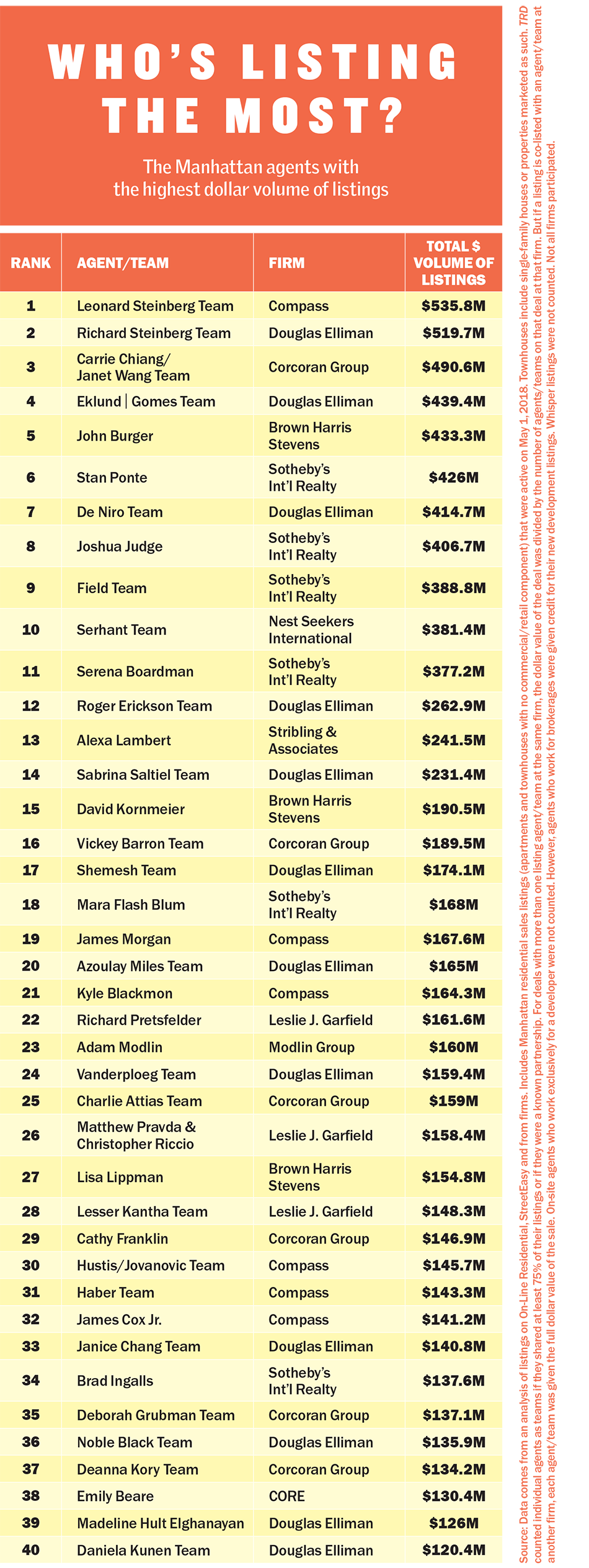Trending
Manhattan’s listing wars
Step one: Land the exclusive. Step two: Cut the price enough to sell it.

They won the listings — but can they sell them?
That’s a question New York’s top residential agents have been grappling with for the past few years, with buyers calling the shots in a slow-moving market. Amid tax-reform jitters in 2017 and a pileup of new condo inventory, an affirmative answer often boils down to one thing: price.
This month, in addition to ranking Manhattan’s top agents by their closed deals, The Real Deal tallied their total dollar volume of listings — which offers a window into who’s locking down exclusives and teeing up the most business.
Related: These Manhattan agents have the highest dollar volume in deals for 2017
TRD also changed its methodology this year.
Rather than giving agents full credit if they shared a listing with another broker at their own firm, we divvied up their dollar volume. (For example, if two brokers from Brown Harris Stevens closed a $30 million deal together, we awarded each $15 million. If there were three BHS agents who shared a listing, each one got $10 million worth of credit.)
As a group, the top 40 agents on the ranking were marketing $9.5 billion worth of listings on May 1, our one-day snapshot of properties listed on On-Line Residential.
Meanwhile, the top 20 agents on TRD’s list this year have $6.6 billion worth of exclusives — roughly the same as last year’s $6.7 billion.

But with inventory in Manhattan rising, brokers said they’re seeing a shift among sellers, who are finally lowering prices or adjusting expectations.
Compass President Leonard Steinberg clocked in at No. 1 with 46 exclusives listed for a combined $535.8 million. He was followed by Douglas Elliman’s Richard Steinberg with $519.7 million worth of listings and the Corcoran Group’s Carrie Chiang and Janet Wang with $490.6 million.
Others at the top of the list were Elliman’s Fredrik Eklund and John Gomes at No. 4 with $439.4 million in listings, followed by Brown Harris Stevens’ John Burger (with $433.3 million) and Sotheby’s International Realty’s Stan Ponte (with $426 million).
Nest Seekers International’s Ryan Serhant — No. 1 on TRD’s closed-sale ranking —clocked in at No. 10 with $381.4 million in Manhattan exclusives.
Zeroing in on Burger and Serhant, though, offers an interesting case study in volume versus exclusivity. Serhant, the co-star of Bravo TV’s “Million Dollar Listing: New York” had 66 Manhattan exclusives, asking an average of $5.7 million each. Meanwhile, Burger had 19 exclusives, asking an average of $22.8 million.
“We’re very aggressive,” said Serhant, who had a mix of new development and resale units priced between $590,000 and $9.5 million at the time of the snapshot. “I try to stay as diversified as possible.”
For Burger, the most expensive of his listings was a palatial co-op at 834 Fifth Avenue — once the city’s priciest listing at $120 million, it’s now listed for $76 million. (He’s sharing the exclusive with Larry Kaiser of Berkshire Hathaway HomeServices New York Properties, who is not on TRD’s ranking.)
“The price adjustment reflects the price of the last transaction in the building in this size category,” Burger told TRD in September.
It’s a sentiment other top agents share.
“My advice is to price tight and hope to get multiple offers,” said Elliman’s Steinberg. “And don’t reach for the sky.”
Listings love
During 2018’s first quarter, Manhattan inventory rose 4 percent year-over-year, to 6,125 properties, according to appraisal firm Miller Samuel. But sales dropped nearly 25 percent, to 2,180 during the same time.
“It’s one of the most difficult years I’ve ever experienced in making things transact,” said Compass’ Steinberg. But he said he doesn’t put stock into rankings because he thinks they drive agents to behave badly. “Agents aren’t horses in a race,” he said.
Whether you believe in rankings or not, they do offer insights into the market. And one trend that’s clearly visible in TRD’s ranking is an uptick in for-sale properties, particularly above $3 and $4 million, where buyers purchase out of “want” rather than “need.”
But with interest rates rising — they are now around 4.5 percent compared to just under 4 percent a year ago — some sellers are eager to list their properties before the market further softens. And agents said that some buildings that have seen little turnover over the past few years are seeing deals pick up.
At 101 Warren Street, for example, sellers have recently begun to trade again after a dry spell. Elliman’s Josh Rubin — who did not make the ranking — attributed the drought at the building to construction at the nearby 111 Murray, which once complete could change comps for the neighborhood. “People feel like the sky is cleared and now is the time to list,” he said, referring to the end of construction at 111.
Meanwhile, for some foreign investors, political unrest (both in their home countries and in the U.S.) has prompted them to list.
Two years ago, Elliman’s Steinberg represented a foreign buyer who paid $42 million for a townhouse at 33 East 74th Street, but then decided to list it last June for $48 million. (The seller cut the price to $45 million in September.)
 “Literally, they decided after eight or nine months that they weren’t going to move to the U.S.,” he said. “They just want to break even.”
“Literally, they decided after eight or nine months that they weren’t going to move to the U.S.,” he said. “They just want to break even.”
Steinberg echoed what many others have said: that sellers have finally become realistic. “They now realize they are going to have to reduce prices slightly to get a deal done,” he said.
According to Serhant, asking prices are subjective. “On the sell side, you try to comp it out, but it’s not always correct,” he said. “The market moves very quickly.”
Elliman’s Tamir Shemesh — whose team ranked No. 17 with $174.1 million in listings — said, however, that some sellers are still in la-la land.
“The faster they understand the reality, the better they do for themselves,” he said. “If you overprice an apartment, you risk actually selling it for less than if you were reasonable in your asking price.”
Still, on the flip side, some buyers have been throwing out lowball offers to test the market, Shemesh said.
Meanwhile, during 2018’s first quarter, the average discount was 5.5 percent, compared to 4.2 percent in 2017, according to Miller Samuel.
Rubin said he recently put a two-bedroom penthouse on East 17th Street into contract after pricing it aggressively. The seller wanted to ask $3.25 million, but Rubin insisted on $2.995 million. The unit went into contract — for $5,000 above the asking price — within four days.
The broker swap
Sometimes it takes a new broker to convince sellers to cut their price.
Back in 2014, the sprawling penthouse at 11 North Moore in Tribeca hit the market asking $40 million.
With no takers, even after a price chop to $25 million, the seller swapped out the brokers — Eklund and Gomes — and brought on their Elliman colleagues, brothers Tal and Oren Alexander, who cut the price to $22.5 million. Shemesh took over the listing in April, but kept the price, which he considered fair based on recent comps. “It should trade,” he said. “Maybe not at the full asking price but at a good price.”
Despite the fact that the Alexanders didn’t have luck, Shemesh thinks his Rolodex could yield the right buyer. “Our network is different,” he said.
Similarly, Serhant said he’s taken over more than a dozen new development projects from other brokers over the past few years.
He personally goes on two to three pitches daily. “That’s my business model — it’s to be the quarterback and CEO for the team and to prospect, bring in and close business,” he said. “My goal is to fuel that pipeline.”
Brokers said any agent who simply uploads a listing and waits for the phone to ring isn’t going to make a deal.
In 2017, Elliman’s Steinberg and his team developed a new strategy and sought out buyers directly rather than depending on co-brokered deals. (Targeting wealthy art patrons and billionaires on annual magazine rankings are just some of their tactics.)
 Technology has changed the brokerage business, Steinberg said, and agents can’t afford to wait for another broker to bring the buyer. “We became a little lazy,” he admitted. “Now we’re aggressively going after our own buyers. No. 1, it’s an opportunity to do better. No. 2, you make twice as much money.”
Technology has changed the brokerage business, Steinberg said, and agents can’t afford to wait for another broker to bring the buyer. “We became a little lazy,” he admitted. “Now we’re aggressively going after our own buyers. No. 1, it’s an opportunity to do better. No. 2, you make twice as much money.”
Corcoran’s Vickey Barron, who ranked No. 16 with $189.5 million in listings, has thrown events specifically aimed at buyers (or people who may know them) rather than hosting broker events.
“I figure out who the end user is going to be for the property, and then I go after those people,” she said.
Barron has hosted a ballroom dancing event at the penthouse at 100 Barclay Street, which is asking $59 million. “Influencers can leave the event and talk about the largest living room in New York,” she said.
Brokers said buyers these days want things to be in mint condition — whether it’s a resale or a new condo that they purchased off a floor plan a few years ago.
Corcoran’s Julie Pham, who was No. 20 on the closed-sale ranking with $113 million in sell-side deals, said buyers are willing to take the plunge on unfinished sponsor units — if the project is backed by a big-name developer.
“In medium to small-sized [projects], buyers want to walk into the unit and see the views and see how big the space is,” she said.
Elliman’s Holly Parker, who also appeared only on the closed-sale ranking, has advised developers to stage units in nearly completed projects rather than have buyers trek around construction sites.
“Do you want to burn up all your days with 500 days on the market when you’re not looking your best?” she asked. “Or would you rather wait and put your best foot forward and be like, ‘Come look at me now.’”
Parker also insists that developers complete all of their punch list items, just as the owner of a resale unit would. “If someone is still painting the ceiling, I wouldn’t put it on the market,” she said. “Why are you the exception? It needs to show perfectly.”
But even triple-mint units aren’t selling if they’re overpriced.
Rubin said properties that are priced 5 to 10 percent too high might as well not be listed. “The only real estate paradigm — location, location, location — in today’s market, it’s now price, price, price.”
— David Jeans contributed reporting to this story.




